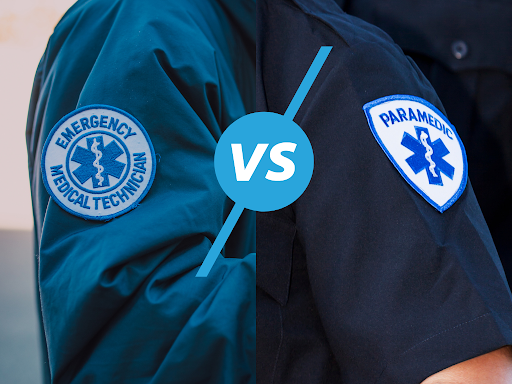The short answer is that a paramedic has additional training and education to an Emergency Medical Technician (EMT). This gives them a greater scope of practice and level of care in the field. So, if you were only Googling “paramedic vs EMT” out of interest’s sake, you’re free to return to your online meanderings.
If, however, you wanted to know the difference between an EMT and paramedic because you intend to become one or the other, this guide covers exactly the information you’re probably looking for, such as:
- What is an Emergency Medical Technician or EMT?
- What is a Paramedic or PM?
- Where does an EMT vs paramedic work?
- What is the paramedic vs EMT salary?
We’ve partnered with nationally registered and certified paramedic and emergency medical services (EMS) instructor, Jeralyn Price, to answer these questions.
Throughout her 33+ year career, Jeri has taught over 100 EMT courses; authored countless exams, evaluations, and matrices; coordinated NREMT psychomotor skills finals at every level; and served as a board member of the Colorado State EMS Education Association.
So, yeah, not to brag or anything, but she knows a whole lot!
Paramedic Vs EMT: What Is An Emergency Medical Technician?

The primary job of an Emergency Medical Technician (EMT) is to assess a patient and determine if any life-threatening injuries or illnesses may be present. This quick assessment is then followed by interventions intended to (1) save the patient’s life, (2) stabilize them for transport, and even (3) provide respite from pain, shock, and emotional distress, for example:
- Splinting injuries for a patient following some kind of accident, such as a car crash
- Administering life-saving epinephrine for a patient in anaphylactic shock
- Giving CPR to a patient in cardiac arrest
- Delivering a newborn baby to a patient who wasn’t able to get to a hospital in time
- Administering oxygen/bag valve mask ventilations to a patient struggling to breathe
Once an EMT has done as much as they can to stabilize the patient in the field, they will then transport (ambulance or helicopter) the patient to a medical facility to receive advanced care.
How Do I Become An EMT?
In order to become an EMT, you have to complete a training course that is between 120 and 150 credit hours in length, which is typically spread out between three weeks and one year.
This training culminates with the National Registry of Emergency Medical Technicians ® (NREMT) examination (a cognitive and psychomotor exam), which tests your content knowledge and practical emergency care skills, respectively.
In general, to be eligible for enrollment at an EMT school, you don’t need any prior medical experience. Beyond that, educational institutions may have some requirements for applicants (such as a minimum age of 18), so make sure you check with your chosen school’s and state’s regulations beforehand.
Side note: Not everyone who gets EMT certification stays an EMT. Many go on to become paramedics (more on that in the next section) or even nurses, firefighters, and doctors!
Paramedic Vs EMT: What Is A Paramedic?

Paramedics actually start out as EMTs (with a minimum of 6 months’ experience) but then complete additional training and certification in order to offer a greater scope of care to patients.
How much additional training?
Well, a paramedic program takes between 1,200 and 1,800 hours, and up to 24 months to complete (although it can be done quicker). This training involves lectures, skills labs, a hospital internship, and then an EMS field internship. Finally, paramedic students are required to pass the national certification exam.
What Skills Do Paramedics Learn Beyond EMT Training?
Paramedic courses build on an EMT education, teaching candidates to provide emergency care to patients with life-threatening medical or traumatic emergencies:
- Administering medications,
- Starting intravenous lines,
- Providing advanced airway management,
- EKG Interpretation for patients,
- Provide emergency care to patients
And while EMTs can perform some invasive procedures—like inserting an oropharyngeal airway (OPA) or injecting an epinephrine pen intramuscular (IM)—paramedics can offer considerably more invasive interventions*, as well as having extensive training in pharmacology, electrocardiograms (EKGs), and treatment.
* The goal is to keep invasive procedures to an absolute minimum in the field to avoid infection. However, if deemed necessary, a paramedic has the training to do it.
Additionally, Paramedics Advanced Cardiac Life Support (ACLS) is required in order for paramedics to maintain their certifications … and this is the same requirement for doctors! In other words, a critical cardiac patient or a patient in cardiac arrest will receive the same standard of care from a paramedic as they would from a doctor!
Paramedic Program Eligibility
In order to be eligible for a paramedic course, you must first become a certified EMT and get a minimum of 6 months’ work experience. The entrance requirements of the various paramedic programs differ from school to school and state to state, so do your research. Here are some pretty common requirements:
- College-level anatomy and physiology prior to admission
- Proof of immunizations
- A physical assessment (good general health and fitness)
- A criminal background check
- Admissions interview
- Entrance exam to determine your eligibility for admission
The goal of having you run through the gauntlet of all these requirements is to ensure that you will be successful in the training program. So while it may seem like a pain in the butt, it keeps the classes narrowed down to those who have the mettle to become paramedics.
And you’re going to want those kinds of people as your classmates!
Where Does An EMT Vs Paramedic Work?

The same places, actually! In fact, EMTs and paramedics often work side-by-side in ambulances, hospitals, governments, fire departments, and police departments.
The difference arises in the scope of care a paramedic vs an EMT is allowed to provide, which we discussed previously. Also, EMTs typically work under the supervision of a doctor or medical director, while paramedics can work more independently in environments requiring a higher level of care.
What Is The EMT Vs Paramedic Salary?
As an unsurprising side-effect of having a more advanced education and training, paramedics tend to receive a greater salary than EMTs. Across the United States, the paramedics earn a median salary of $58,000, while EMTs earn a median salary of $41,340.
The exact rates vary from state to state and from country to country. In Appleton, Wisconsin, the median EMT salary is $29,280, while in Tacoma, Washington, the median salary is $64,166.
Meanwhile, the median salary for paramedics varies from $45,020 in Alabama to $100,780 in Washington.
Use a website like Indeed or Glassdoor to crunch the numbers where you live (or where you're thinking of working).
A Final Note On What It Means To Be A Paramedic Vs EMT

EMTs and paramedics are both Emergency Medical Service responders; both wear uniforms; work in ground ambulances, fire departments, industrial safety, or helicopters; and care for patients and save lives.
But if there’s one key difference, it’s that paramedics have additional education and training, which enables them to offer more advanced medical care in the field; sometimes that which is on par with what a doctor can offer.
Also, it should be remembered that an EMS education never ends! As long as medicine and technology continue to evolve, you’ll need to dedicate yourself to ongoing education. Digital flashcards are the perfect study tool for the job: they're the most efficient way to memorize information.
With that said, we wish you all the very best. Whichever path you choose in the medical field, you're saving lives, and that's what really matters.
Additional Reading
- How to get your EMT training done more efficiently
- What to expect from EMT school
- EMT Jobs: how to get one and be successful
References
8 highest-paid EMT Jobs (with salaries and locations) | indeed.com. (n.d.). https://www.indeed.com/career-advice/finding-a-job/highest-paid-emt-jobs
Kelleher, E. (n.d.). Lowest paying Metros for emts. Stacker. https://stacker.com/stories/careers/lowest-paying-metros-emts
Paramedic salary guide. Nurse.org. (n.d.). https://nurse.org/healthcare/paramedic-salary/
U.S. Bureau of Labor Statistics. (2025, August 28). EMTs and Paramedics. U.S. Bureau of Labor Statistics. https://www.bls.gov/ooh/healthcare/emts-and-paramedics.htm
